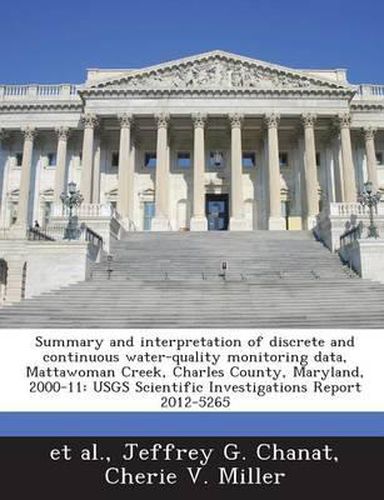Readings Newsletter
Become a Readings Member to make your shopping experience even easier.
Sign in or sign up for free!
You’re not far away from qualifying for FREE standard shipping within Australia
You’ve qualified for FREE standard shipping within Australia
The cart is loading…






Discrete samples and continuous (15-minute interval) water-quality data were collected at Mattawoman Creek (U.S. Geological Survey station number 01658000) from October 2000 through January 2011, in cooperation with the Charles County (Maryland) Department of Planning and Growth Management, the Maryland Department of the Environment, and the Maryland Geological Survey. Mattawoman Creek is a fourth-order Maryland tributary to the tidal freshwater Potomac River; the creek’s watershed is experiencing development pressure due to its proximity to Washington, D.C. Data were analyzed for the purpose of describing ambient water quality, identifying potential contaminant sources, and quantifying nutrient and sediment loads to the tidal freshwater Mattawoman estuary. Continuous data, collected at 15-minute intervals, included discharge, derived from stage measurements made using a pressure transducer, as well as water temperature, pH, specific conductance, dissolved oxygen, and turbidity, all measured using a water-quality sonde. In addition to the continuous data, a total of 360 discrete water-quality samples, representative of monthly low-flow and targeted storm conditions, were analyzed for suspended sediment and nutrients. Continuous observations gathered by a second water-quality sonde, which was temporarily deployed in 2011 for quality-control purposes, indicated substantial lateral water-quality gradients due to inflow from a nearby tributary, representing about 10 percent of the total gaged area upstream of the sampling location. These lateral gradients introduced a time-varying bias into both the continuous and discrete data, resulting in observations that were at some times representative of water-quality conditions in the main channel and at other times biased towards conditions in the tributary. Despite this limitation, both the continuous and discrete data provided insight into the watershed-scale factors that influence water quality in Mattawoman Creek.
$9.00 standard shipping within Australia
FREE standard shipping within Australia for orders over $100.00
Express & International shipping calculated at checkout
Discrete samples and continuous (15-minute interval) water-quality data were collected at Mattawoman Creek (U.S. Geological Survey station number 01658000) from October 2000 through January 2011, in cooperation with the Charles County (Maryland) Department of Planning and Growth Management, the Maryland Department of the Environment, and the Maryland Geological Survey. Mattawoman Creek is a fourth-order Maryland tributary to the tidal freshwater Potomac River; the creek’s watershed is experiencing development pressure due to its proximity to Washington, D.C. Data were analyzed for the purpose of describing ambient water quality, identifying potential contaminant sources, and quantifying nutrient and sediment loads to the tidal freshwater Mattawoman estuary. Continuous data, collected at 15-minute intervals, included discharge, derived from stage measurements made using a pressure transducer, as well as water temperature, pH, specific conductance, dissolved oxygen, and turbidity, all measured using a water-quality sonde. In addition to the continuous data, a total of 360 discrete water-quality samples, representative of monthly low-flow and targeted storm conditions, were analyzed for suspended sediment and nutrients. Continuous observations gathered by a second water-quality sonde, which was temporarily deployed in 2011 for quality-control purposes, indicated substantial lateral water-quality gradients due to inflow from a nearby tributary, representing about 10 percent of the total gaged area upstream of the sampling location. These lateral gradients introduced a time-varying bias into both the continuous and discrete data, resulting in observations that were at some times representative of water-quality conditions in the main channel and at other times biased towards conditions in the tributary. Despite this limitation, both the continuous and discrete data provided insight into the watershed-scale factors that influence water quality in Mattawoman Creek.